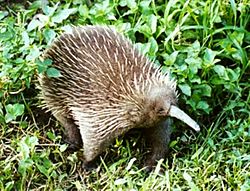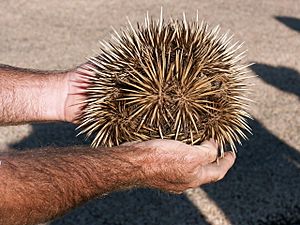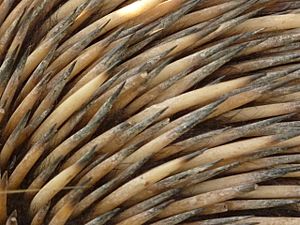Echidna facts for kids
Quick facts for kids Echidnas |
|
|---|---|
 |
|
| Western Long-beaked Echidna | |
| Scientific classification | |
| Kingdom: | |
| Phylum: | |
| Class: | |
| Order: | |
| Family: |
Tachyglossidae
Gill, 1872
|
| Species | |
|
Genus Tachyglossus |
|
Echidnas, also known as spiny anteaters, are unique mammals. They live in Australia and New Guinea. These animals belong to a special group called monotremes. This means they are mammals that lay eggs!
Echidnas have a long, tube-like mouth and a sticky tongue. Their bodies are covered in sharp spines. They also have mammary glands, which produce milk for their babies.
Echidnas have a clever way to protect themselves. They use their long, sharp claws to quickly dig a hole. They dig until only their spines are showing. This makes it very hard for a predator to reach them without getting hurt. If there's a fire, echidnas can dig deep underground to stay safe.
Contents
Description
Echidnas are medium-sized mammals. They have coarse hair and many spines. They often look like the anteaters from South America. They also resemble other spiny animals like hedgehogs and porcupines. Echidnas are usually black or brown.
They have long, thin snouts that work as both a mouth and a nose. Like the platypus, echidnas can sense electricity. This helps them find food. They have very short, strong limbs with big claws. This makes them excellent diggers.
Echidnas have tiny mouths and no teeth. They eat by tearing open soft logs or anthills. Then, they use their long, sticky tongue to pick up their prey. Their ears are slits on the sides of their heads. You usually can't see them because their spines cover them.
Diet
The short-beaked echidna mainly eats ants and termites. The Zaglossus species, which are the long-beaked echidnas, usually eat worms and insect larvae.
The tongues of long-beaked echidnas have tiny, sharp spines. These spines help them catch their prey. Since they don't have teeth, they grind their food. They do this between the bottom of their mouths and their tongues.
Habitat
Echidnas do not like very hot or very cold weather. They use caves and cracks in rocks to hide from harsh conditions. You can find echidnas in forests and woodlands. They often hide under plants, tree roots, or piles of leaves. Sometimes, they even use burrows dug by other animals, like rabbits or wombats. Each echidna has a large area where it lives. These areas often overlap with other echidnas' territories.
Life Cycle and Reproduction
The average echidna lives for about 16 years in the wild. A fully grown female can weigh up to 4.5 kilograms (9.9 lbs). Males can be heavier, weighing up to 6 kilograms (13.2 lbs).
The female echidna lays a single egg about 22 days after mating. The egg has a soft, leathery shell. She places it right into her pouch. The egg is small, about 1.4 centimeters long. When the baby echidna is ready to hatch, it uses a reptile-like egg tooth to open the shell.
Hatching happens after 10 days. The baby echidna, called a puggle, drinks milk from its mother's milk patches. Monotremes do not have nipples. The puggle stays in the pouch for 45 to 55 days. During this time, it starts to grow spines. The mother then digs a special burrow for her young. She leaves the puggle there and returns every five days to feed it. The puggle stays with its mother until it is about seven months old. Young puggles might stay in their mother's den for up to a year before leaving.
The breeding season starts in late June and lasts until September. Male echidnas form a line, sometimes up to ten individuals long. The youngest echidna is usually at the very end. This line follows the female, trying to mate with her. This behavior is called the "train" system.
Threats
Echidnas are shy animals. When they feel in danger, they try to bury themselves. If they are out in the open, they will curl into a ball. Both methods use their spines to protect them. Their strong front arms help them dig in and hold tight if a predator tries to pull them out. Even with these defenses, echidnas still face many dangers.
Some of their predators include wild cats, foxes, domestic dogs, and goannas. Snakes are also a big threat. They can slither into echidna burrows and eat the young, spineless puggles.
We can help protect echidnas by keeping their environment clean. This means picking up litter and reducing pollution. Planting more trees and plants gives them places to hide. It's also important to supervise pets and report any hurt echidnas. It's best to leave them alone if you see one. Picking them up can cause stress or even injure them.
Echidna Species
Echidnas are grouped into three main types, called genera. The genus Zaglossus includes three living species and two species known only from fossils. The genus Tachyglossus has only one living species. The third genus, Megalibgwilia, is only known from fossils.
Long-beaked Echidnas (Zaglossus)
The three living Zaglossus species are found only in New Guinea. They are rare and sometimes hunted for food. They search for food in leaf litter on the forest floor, eating earthworms and insects. The species are:
- Western long-beaked echidna (Z. bruijni), found in highland forests.
- Sir David's long-beaked echidna (Z. attenboroughi), which prefers even higher habitats.
- Eastern long-beaked echidna (Z. bartoni), which has four different types.
Short-beaked Echidna (Tachyglossus)
The short-beaked echidna (Tachyglossus aculeatus) lives in southern, southeast, and northeast New Guinea. It also lives in almost all parts of Australia. You can find it from the snowy Australian Alps to the dry Outback. They live wherever ants and termites are available. This species is smaller than the Zaglossus species and has longer hair.

Interesting facts about echidnas
- Echidnas are solitary animals. They usually live alone, except when they are looking for a mate.
- Some echidnas have albinism. This means their eyes are pink and their spines are white.
- Long-beaked echidnas have 2,000 special sensors on their snout that detect electricity. Short-beaked echidnas, which live in drier places, have fewer than 400.
- Echidnas are good swimmers. When they swim, their snout and some spines stick out of the water. They are known to go into water to clean themselves.
- Echidnas and the platypus are the only mammals that lay eggs. They are called monotremes.
- You can often guess an echidna's sex by its size. Males are usually 25% larger than females.
- Male echidnas have non-venomous spurs on their back feet.
- Echidnas live a long time for their size. The longest recorded lifespan for an echidna in a zoo is 50 years. This is because they have a slow metabolism.
- Aboriginal Australians consider the echidna a special food.
- The echidna appears on the back of the Australian five-cent coin.
- Millie, an echidna, was a mascot for the 2000 Summer Olympics.
- An echidna's milk is pink because it has a lot of iron in it.
Images for kids
-
The Western long-beaked echidna, which is found only in New Guinea
See also
 In Spanish: Equidnas para niños
In Spanish: Equidnas para niños




